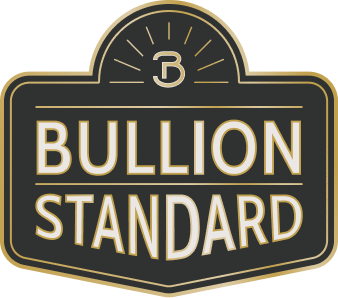The Correlation Between Interest Rates and Bullion Demand
By Bullion Standard ·
6 min read
Gold has always been a go-to precious metal for investors seeking financial security. But before diving into the precious metal market, it’s essential to consider some key factors that can influence your investment—like interest rates.
When interest rates rise or fall, the demand for gold adjusts accordingly. Being able to recognize and understand how this connection works is crucial for smart investing.
Bullion Standard is here to help you see the bigger picture, so you can make informed decisions about your portfolio. In this post, we’ll explain the link between interest rates and bullion demand, so you can anticipate market movements and make more strategic investment decisions.

The Basics: What are Interest Rates and Bullion?
Bullion
Bullion refers to the physical forms of precious metals, primarily gold and silver, that are bought and sold as investments. These metals are typically shaped into bars, coins, or ingots, with their value determined by weight and purity.
Unlike paper currencies or stocks, bullion is a tangible asset that doesn’t rely on a third party to retain its worth. Investors choose bullion as a way to store wealth, hedge against inflation, and protect against economic uncertainties.
Interest Rates
When you take out a loan, you pay interest, and the interest rate determines how much that loan costs over time. Central banks, like the Federal Reserve in the U.S., control the base interest rate.
When central banks change rates, it can have a ripple effect on many asset classes, including gold bullion.
Gold and Interest Rates: How High Rates Impact Demand
1. Lower Demand for Non-Yielding Assets
When interest rates are high, the market tends to move away from gold. Since gold does not produce interest or dividends, investors may see greater returns elsewhere.
This shift can significantly reduce the demand for bullion, especially among those looking for short-term gains rather than long-term wealth preservation.
2. A Stronger Dollar Means Less Bullion Demand
High interest rates often strengthen the U.S. dollar, as higher rates attract foreign investment. When the dollar becomes stronger, it makes gold more expensive for buyers using other currencies.
This increased cost can dampen international demand, especially in countries where investors face higher conversion costs. As a result, bullion demand typically declines during periods of a strong dollar, especially in global markets.
3. Rising Bond Yields
As interest rates rise, bonds and other fixed-income assets start to offer more attractive yields. Investors looking for stable, income-generating investments may shift their portfolios toward bonds, which are seen as lower-risk compared to gold.
Additionally, rising bond yields signal a healthy economy, which can further lessen the need for safe-haven assets like gold.
How Low Interest Rates Increase Bullion Demand
1. Safe-Haven Asset
Investors tend to flock to gold as a stable asset that can hold its value when other investments are perceived as risky. For instance, during periods of low interest rates, bullion demand often rises.
This behavior is especially common during recessions or financial crises, where low interest rates coincide with heightened concerns about market volatility and currency stability.
2. Inflation Hedge
Low interest rates can also lead to higher inflation, as central banks lower borrowing costs to stimulate economic activity. Over time, this increased money supply can drive up prices, eroding the purchasing power of currencies.
When there's high inflation, gold is often seen as a reliable hedge. The negative correlation between interest rates and gold demand leads many investors to shift toward bullion during inflationary periods.
3. Weak US Dollar
Low interest rates usually weaken the U.S. dollar. A weaker dollar makes gold cheaper for international buyers, as it takes less of their local currency to purchase the same amount of bullion.
This currency shift can significantly boost global demand for gold. As international buyers enter the market, prices often go up. This pattern reinforces gold’s appeal as a valuable asset during low-interest-rate periods.
Historical Examples of Gold and Interest Rates
Throughout history, there have been instances where bullion demand has been directly influenced by interest rates. Here are two notable examples:
- The 2008 Financial Crisis: During the 2008 financial crisis, the Federal Reserve slashed interest rates to near zero. This led to a surge in gold demand as investors sought refuge in bullion as a hedge to protect their assets.
- The 2020 Pandemic: In 2020, the COVID-19 pandemic caused central banks to lower interest rates again. As a result, gold prices soared, reflecting increased demand for bullion as a safe haven during uncertain times.
Federal Reserve Rate Hikes and Their Effect
Fed rate hikes can have a significant impact on gold prices even before the changes take place.
If the Federal Reserve is expected to raise rates, many investors may sell gold futures in anticipation of lower demand for the metal.
On the other hand, when the market expects the Fed to cut rates (like they just recently did), the demand for gold futures often increases. Moreover, rate cuts can signal economic uncertainty or a need to stimulate growth, both of which drive investors to seek safer investments like gold.
What This Means for Investors
Use Bullion as a Diversification Strategy
Knowing the link between gold, interest rates, and supply and demand dynamics can help you build a well-rounded, diversified portfolio. It allows you to make strategic decisions about when to buy or hold gold as part of your long-term financial plan.
Time Your Purchases Correctly
Monitoring gold and interest rates trends can be a valuable tool for timing your gold purchases. When interest rates are expected to drop, it often signals increased demand for gold. By anticipating these trends, investors can position themselves to buy bullion before demand spikes and prices rise.

Wrapping Up: The Gold-Interest Rate Connection
The link between gold and interest rates may seem tricky at first, but once you understand it, it can give you an edge in your investment strategy. When rates rise, gold demand tends to dip. But when rates are low, gold’s appeal as a safe-haven asset really shines.
By staying alert to changes in interest rates, inflation, and broader market trends, you can make smarter choices about when to buy or sell your bullion.
At Bullion Standard, we’re committed to helping you navigate the nuances of gold investing. Whether you’re a first-time buyer or a seasoned investor, we have the insights you need to make well-informed decisions. Shop online today and discover how gold can play a vital role in your financial strategy.






















